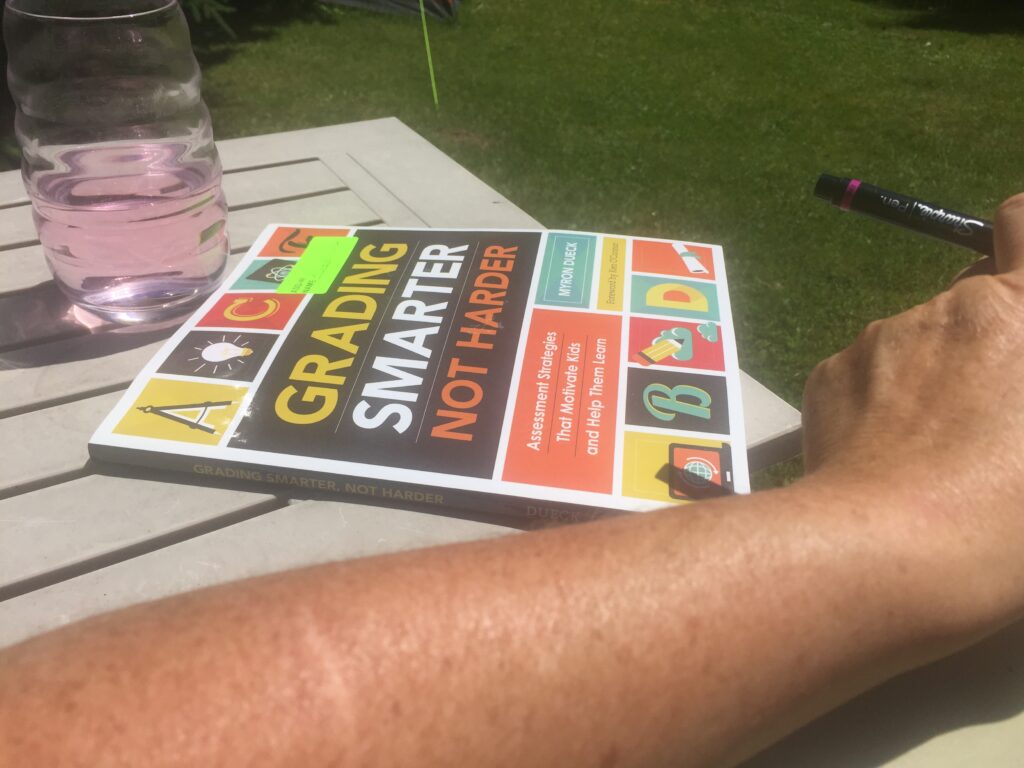Title: Grading Smarter Not Harder: Assessment Strategies that Motivate Kids and Help Them Learn
Author: Myron Dueck
Date Read: July 7, 2019
Two Snaps

I was lucky to have attended a conference in which Myron Dueck was the keynote speaker. He is funny, energetic, and engaging, but most importantly, he cares about finding ways to engage students in their learning and finding assessment practices that fairly assess student knowledge and understanding.
Grades are a nebulous hangover of generations of teachers advancing the ways in which they had school done to them. For the most part, grading has served primarily to sort and rank students. Furthermore, schools have trained students to be grade-focused rather than learning-focused (Dueck, 101). The book outlines the common beliefs and misconceptions about grading practices while offering solutions and four key lessons: 1. By grading smarter, teachers can reduce their workloads; 2. we would do well to think more like coaches– looking for things we can do to move to the next level of performance– in effect, assessment of learning; 3. learning is more important than grades; and 4. relationships are crucial.
Dueck walks teachers through five key issues in re-thinking their pedagogy and assessment: grading, homework, unit plans, retesting and creativity.
As far as grading goes, Dueck asks teachers to think more carefully about the use of punitive grading; like zeroes and late penalties. Most importantly, he argues, despite the fact that these penalties rarely modify behaviour– the accuracy of the grading data is also compromised. We are now assessing behaviour, not the student’s ability to meet a learning target.
On a four point scale, where “A” = 4, “B” = 3, and so on, the zero is accurate, because the difference between the A, B, C, D and F are all equal– one point. But assigning a zero on a 100-point scale is a math error; it implies a 60-point difference between the D and the F, while the other differences are typically about 10 points. It makes missing a single assignment the “academic death penalty.” It’s not just unfair — it is not mathematically accurate.
(from Doug Reeves, 2010, p.11)
Dueck also tackles the issue of homework. Specifically: “…assignments designed to serve as a follow-up or practice usually designed to yield identical answers from every student.” (p.44) Many teachers rely on assigning homework because they believe that they are instilling a work ethic in today’s youth; the problem with this well-intended argument is that attaching a grade to homework inevitably leads to grading completion rather than understanding.
He provides excellent suggestions on unit planning, and how it is beneficial for both organizing teaching and learning. Unit plans offer students road maps to focus on where they are in their own learning. He wisely suggests that students also be provided with samples of what excellence looks like as they work to complete products of their own. He models key questions to help teachers make their own quality unit plans, while offering samples to lead the way.
He devotes his fourth chapter to retesting. In nearly every other area of the real world, he says, we embrace and celebrate mastery through repeated effort– so what are tests and exams meant to emulate? Testing can only give us information on a single moment in time, which can be affected by variables totally unrelated to the learning targets.
I was most impressed with how Dueck focuses throughout the book on the multitude of variables that affect learners and why a re-thinking of our practices are crucial. These include but are not limited to: socio-economic status; learning disabilities; chronic stress and anxiety; drug use and abuse; violence in the home; and a lack of nutritious food. It is evident that Dueck’s motivation is not simply about making grading easier for teachers, but rather has arisen from a place of caring deeply about the students he serves.
His final chapter focuses on creativity which he contends is: required to solve problems; needed in a world that rewards the unique; and helps students to develop autonomy.
The human condition is based on connection and socialization. As a species, we’ve been storytellers since long before the advent of the written word. We draw meaning from interaction more so than from homework or lectures (Geary, 2011). Research confirms that when people are spurred on by curiosity, they learn more (Engel, 2013), and when intrigue and surprise are added to the mix, they remember more (Engel, 2013; Garner, Brown, Sanders, & Menke, 1992).
(Dueck, p.121)
Educators, most especially in high school, would do well to spend some time with Dueck, and allow him to guide them through an examination of their own teaching and grading practices. He offers current research; rich examples and detailed work samples; and a multitude of personal story sidebars that reveal his benevolence for his students and his desire to create a classroom where they are met with success.

One Reply to “Book Snap #53”
Comments are closed.